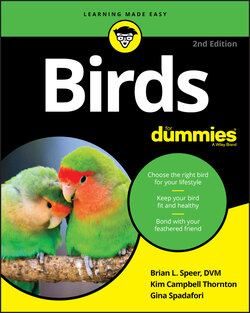Читать книгу Birds For Dummies - Gina Spadafori - Страница 55
Cockatoos
ОглавлениеCockatoos have a reputation as “love sponges” — birds who, in some folks’ minds, would choose to be “surgically grafted” onto their human companion. That’s only half the story, though. Cockatoos are often said to come in two basic behavioral types: the “love sponge” and the “hyperactive child.”
Umbrellas, Galahs (see Figure 2-6), and Moluccans are in the first group. These flashy birds can easily be taught or led to expect close human contact, all the time. Needless to say, a bird who demands attention 28 hours a day can be a royal pain in the tail feathers. Ultimately, the relationship doesn’t end well if the birds are denied what they’ve come to expect as normal. They can develop significant behavioral problems (aggression, screaming, feather picking), as well as a number of medical problems.
The “hyperactive child” is best represented by Goffin’s and bare-eyed cockatoos. Not always so keen on snuggling, these clowns never met a toy (or cage door) they couldn’t figure out and take apart. Some of these birds require padlocks on their cages to keep them from escaping — and not combination locks, either! Goffin’s and bare-eyeds learn trick behaviors quickly and perform them with great enthusiasm. These guys really need to have lots of jobs to do. Keeping their minds and bodies engaged is an essential part of helping them maintain a balanced life with you.
Living with a cockatoo means never a dull moment in your household, that’s for sure. Prices range from $700 for some of the smaller species, such as Goffin’s cockatoos, or $1,000 to $5,000 for species such as umbrella cockatoos, Moluccans, or Major Mitchell’s. Rare species such as some of the black cockatoos can run $20,000 and up. Life expectancies can theoretically hit 100 years for the larger species, although in most countries, birds over 60 to 70 years are relatively uncommon. Most can and should live longer through better care and nutrition.
We recommend that people with allergies (particularly to feathers or feather dust) steer clear of cockatoos. They’re among the dustiest of birds, distributing lots of feather dust and dander.
Photograph courtesy of Rachel Baden, DVM
FIGURE 2-6: Galahs, sometimes referred to as rose-breasted cockatoos, aren’t necessarily cuddlers but they are friendly and affectionate.
